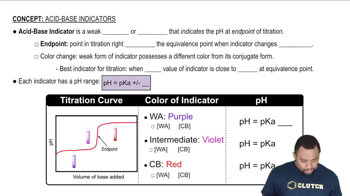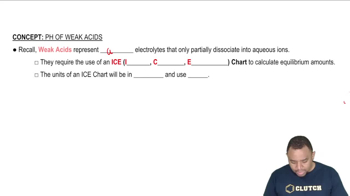Here are the essential concepts you must grasp in order to answer the question correctly.
pKa and Acid-Base Equilibrium
The pKa value of an acid indicates its strength and the degree to which it dissociates in solution. A lower pKa value corresponds to a stronger acid, meaning it more readily donates protons (H+). In this case, butyric acid has a pKa of 4.84, which helps determine its behavior in a solution and the resulting pH when dissolved.
Recommended video:
Henderson-Hasselbalch Equation
The Henderson-Hasselbalch equation relates the pH of a solution to the pKa of an acid and the concentration of its conjugate base. It is expressed as pH = pKa + log([A-]/[HA]). This equation is particularly useful for calculating the pH of weak acid solutions, such as butyric acid, by considering the ratio of the concentrations of the dissociated and undissociated forms.
Recommended video:
Henderson-Hasselbalch Equation
Weak Acids and Their Dissociation
Weak acids, like butyric acid, do not completely dissociate in solution. Instead, they establish an equilibrium between the undissociated acid (HA) and its ions (A- and H+). The concentration of the acid and its dissociation constant (Ka) are crucial for calculating the pH, as they determine how much of the acid remains undissociated versus how much has dissociated into ions.
Recommended video:
 Verified step by step guidance
Verified step by step guidance


